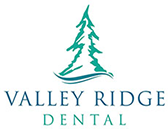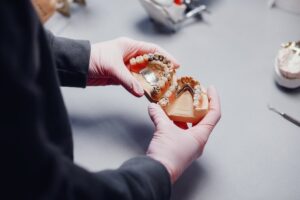A bright smile is a sign of good oral health, but plaque buildup on your teeth can dull its sparkle. But fear not. We’ve got you covered with our guide on how to remove plaque from teeth.
Maintaining healthy gums and teeth is crucial because we use our mouths for eating, drinking, and communicating daily. Your teeth must be adequately cared for to stay strong and healthy.
Plaque is a pesky film of bacteria that clings to your pearly whites, causing everything from cavities to gum disease. You can keep your teeth healthy and free from plaque by choosing the right toothbrush, flossing like a pro, and even using natural remedies like oil pulling and baking soda.
So, whether you’re searching for how to remove plaque from teeth or prevent its buildup, our comprehensive guide has everything you need for a dazzling smile. Get ready to say cheese with confidence!
What is Plaque?
Plaque refers to a sticky, colorless film of bacteria that coats your teeth and gums. This film constantly forms on our teeth and comprises bacteria, food particles, and saliva. Plaque is one of the main culprits of tooth cavities and gum disease.
Plaque can also accumulate on the gums and dental roots, weakening the bones that support teeth. Tartar can develop from untreated plaque and is challenging to eliminate. Plaque is removed by practicing good oral hygiene, including brushing and flossing daily.
How Does Plaque Build-up Affect My Teeth?
Plaque can harm your mouth by accumalating on your teeth if you don’t clean them frequently enough. Removing plaque is crucial because it stops tartar from developing on your teeth. Plaque accumulating outside your teeth and along the gum line hardens into tartar.
Your gums may become sore and swollen due to plaque and tartar. Gum bleeding and other tooth decay symptoms are typically the earliest indications of gum disease, which this inflammation might cause. Cavities in the teeth can cause various oral infections, which can be unpleasant and result in tooth loss if not treated.
How to Remove Plaque From Teeth Using Home Remedies
It’s simple to get rid of that sticky plaque. Cleaning your teeth thoroughly on all surfaces, between teeth, and below the gum line can help eliminate the food particles that bacteria feed on. Below are mentioned some ways through which you can know how to remove plaque from teeth naturally.
Brushing Your Teeth
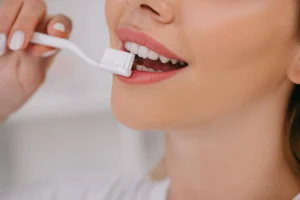
Brush your teeth at least twice a day for at least two minutes to stop deterioration and bacterial growth. Plaque can be eliminated without applying a lot of force or rigorous brushing. Plaque and leftover food particles can be removed from by using a soft-bristled toothbrush with fluoridated toothpaste.
Bacteria adore the carbs in soda, snacks, and sweets. Because of this, maintaining plaque control requires restricting your consumption of these meals and drinks while brushing and cleaning your teeth.
Flossing Your Teeth
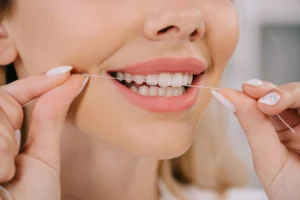
Cleaning between your teeth and beneath the gum line is essential to remove biofilm and plaque and prevent gingivitis and tooth decay. There are numerous items available that can clean those confined spaces.
- Using regular dental floss, which may be shaped to fit in between your teeth, you can clean all surfaces of each tooth.
- To clean between teeth, use water flossers that employ a water jet to clear debris.
- If you have braces or another obstruction that prevents you from flossing with dental floss, dental picks can get in between your teeth.
For advice on flossing items, speak with your dental hygienist. You may also seek the ADA Seal of Acceptance on the organization’s approved products.
Baking Soda
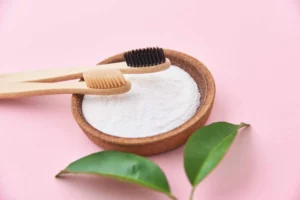
According to research, people who used toothpaste with baking soda eliminated more plaque and saw a reduction in plaque that grew back over the next 24 hours than those who used toothpaste without baking soda.
Baking soda is a natural cleaner and abrasive, making it suitable for cleaning and helpful at eliminating plaque.
Oil Pulling
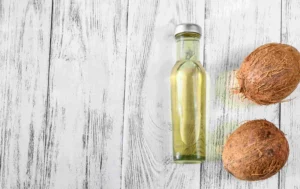
Oil, typically coconut oil, helps in removing hard plaque. It can also be swished in the mouth to strengthen teeth, stop tooth decay, relieve sore gums, and remove plaque.
When you do an “oil pull,” swish one tablespoon of oilve oil or coconut oil in your mouth for 20 to 30 minutes (far longer than you would with regular mouthwash). Coconut oil is considered exceptionally healthy because it includes fatty acids like lauric acid, a compound with anti-inflammatory and antibacterial properties.
How to Remove Plaque From Teeth With a Dentist
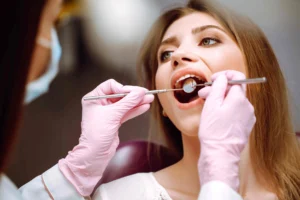
You might still overlook some plaque along your gum line and on and between your teeth, even after brushing and flossing. That’s why you need to make routine appointments with your dentist. They are experts in knowing how to remove plaque from your teeth.
Every six months, schedule a visit with your dental hygienist to have your teeth thoroughly cleaned. They can assist you in cleaning any plaque you might have missed, identify any gum disease symptoms, and provide possible treatments.
You may need to schedule more frequent dental visits with your dentist if your gums or teeth deteriorate. If your gums start deteriorating, you might need to see the dentist or a dental hygienist every three to four months.
How Can I Prevent Plaque Build-Up?
- Flossing Daily: Floss once daily with dental floss or a water flosser to eliminate food and plaque stuck between teeth. Studies show that flossing before cleaning your teeth helps remove more plaque.
- Brushing Twice a Day: Brush your teeth for two minutes twice each day with a soft-bristled toothbrush (manual or powered) and fluoride toothpaste.
- Chewing Sugarless Gum: If you can’t brush soon after eating or drinking, chew sugar-free gum. Select a product with the ADA seal, which stands for the American Dental Association.
- Choosing Healthy Foods: Cut back on sugary, starchy foods and drinks. Choose healthy alternatives like plain yogurt, cheese, raw veggies, and fruit.
- Seeing Your Dentist: Get dental checkups at least twice a year.
- Using Mouthwash: Rinse with an over-the-counter or prescription antiseptic mouthwash.
Bottomline
Plaque will build up less on your teeth the better you care for them. To stop plaque buildup, clean your teeth at least twice daily and floss once. Remember to schedule routine cleanings and preventative maintenance appointments with your dentist. Long-term health is ensured by practicing appropriate mouth hygiene. Ask your dentist for tips and recommendations that can guide you on how to remove plaque from teeth. If you suspect that plaque buildup is the cause of your dental problem, make an appointment with the dentist at Valley Ridge Dental. Call us at 6514390322 now!
